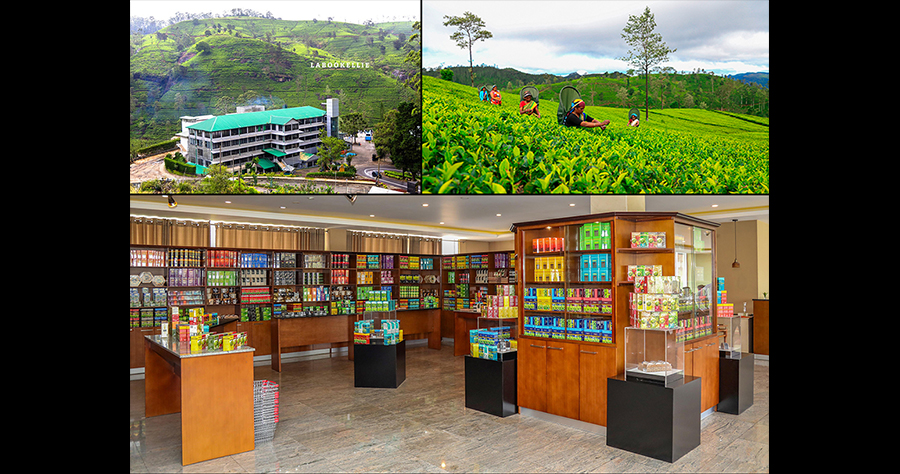Established in 1870, this plantation has stood the test of time as one of the country’s most renowned tea estates, blending heritage, innovation and community service in a way that continues to shape the identity of Ceylon Tea.
Today, under the visionary stewardship of the Damro Group, Labookellie remains both a symbol of Sri Lanka’s tea legacy and a vibrant contributor to its economy and culture.
From Colonial Beginnings to Modern Excellence
The origins of Labookellie trace back to 1870, when it was first established in Ramboda under colonial ownership.
Initially managed by Ceylon Co. Ltd. and later Eastern Produce & Estates Co. Ltd., the estate quickly gained recognition for producing tea of exceptional quality.
By the late 19th century, its green leaf had become prized for its distinct flavor profiles, light, brisk and floral, characteristic of high-grown teas cultivated above 1,500 meters.
Labookellie was among the first estates to experiment with high-grown cultivation and played a formative role in the island’s tea auctions and exports.
Its Condegalla Division tea bushes, planted in 1867 from seeds imported from China by Solomon and Gabriel De Worms, are among the oldest commercial tea bushes in Sri Lanka and are still maintained today.
Around the same period, James Taylor planted the first tea clearing at Loolecondera Estate and visited Condegalla Estate with William Mackwood, laying the foundations of Sri Lanka’s global tea industry.
The estate’s original name, Labukele, referred to a jungle filled with Labu (a type of melon consumed by villagers).
This jungle was cleared to plant tea and the stream that flows through it, Kuda Oya, remains one of the main streams feeding the Kotmale Reservoir.
Following nationalization in the 1970s, Labookellie came under the Janatha Estates Development Board (JEDB), which managed its operations for over two decades.
The 1992 privatization process ushered in a new era, with Agalawatte Plantations Ltd. taking over its lease.
Through the years, leading plantation agents, including Mackwoods, Free Lanka and Browns Plantations, guided its growth.
Following its acquisition by the Damro Group in 2017, the estate embarked on an aggressive modernization drive.
The technology, sustainable best practices and community empowerment into daily operations ensure that Labookellie teas remain among the most sought-after sources of Pure Ceylon Tea.
Cultivating Heritage, People, and Sustainability
Spanning more than 537 hectares, including the amalgamated Westward Ho! and Condegalla Estates, Labookellie employs over 435 workers, 65% of whom are women, forming the foundation of livelihoods across the Ramboda region.
Community empowerment is central to its operations.
Estate families benefit from child development centres, educational scholarships and co-operative societies providing financial services and subsidized provisions.
Healthcare initiatives, including dispensaries, mobile clinics and an ambulance with trained medical and welfare staff, ensure access to care.
Housing and sanitation projects uplift living standards, and annual award ceremonies recognize the dedication of workers, reinforcing a culture of dignity and respect.
Labookellie is a model for sustainable agriculture, holding certifications including Rainforest Alliance, ISO 22000 Food Safety Management, HACCP and ISO 9001-2000.
Practices such as contour planting, soil conservation, rainwater harvesting and natural pest management safeguard the estate’s ecological balance.
Innovations like drone spraying and energy-efficient machinery reduce its carbon footprint, aligning with global ethical sourcing trends.
Beyond production, the estate is a cultural icon. Its colonial-era Manager’s Bungalow and green carpets of tea fields are part of Sri Lanka’s visual heritage, attracting artists, photographers and travelers.
The estate also preserves a living legacy in its Condegalla Division tea bushes, planted over 160 years ago, which still produce some of the finest cups of traditional Pure Ceylon Tea.
A Gateway Through Tea and Tourism – Iconic Labookellie Tea Centre
Perched at an elevation of 5,250 feet along the scenic Kandy–Nuwara Eliya Road, the Labookellie Tea Centre is owned by Agalawatte Plantations PLC and managed by the Damro Group.
It welcomes thousands of visitors annually to the heart of Sri Lanka’s tea country, offering an immersive journey into Ceylon tea heritage.
Visitors can enjoy freshly brewed tea while overlooking lush green valleys, explore the factory to witness the traditional process of tea-making and purchase premium teas, including the Labookellie Special Blend.
The Tea Centre combines natural beauty, rich history and interactive experiences, making it a destination in itself.
Tourism at the estate strengthens the local economy, supporting trade, hospitality and cultural exchange, while offering a global gateway into Sri Lanka’s tea culture.
Labookellie’s factory, situated at 5,250 ft, with the highest point of the estate at 6,900 ft, was the first tea factory in the Central Region to receive a Three-Star Award in 2005 for good manufacturing practices by the Industrial Development Authority.
A Living, Evolving Monument to Ceylon Tea
Labookellie Estate continues to play a vital role in sustaining Sri Lanka’s foreign exchange earnings, with every kilogram of tea exported representing the country’s centuries-old reputation for producing the world’s finest black tea.
The estate balances tradition with innovation, nurtures communities, safeguards the environment and strengthens Sri Lanka’s global identity through tea.






















